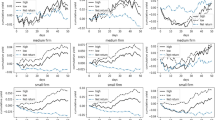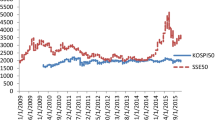Abstract
We argue that continuous rising (falling) share prices might cause herding behaviors due to investors’ sentiments aroused. To my best of our understanding, we argue that this study pioneers to explore the trading performance after continuous rising (falling) prices, which might contribute to the existing literature in finance. By employing the constituent stocks of DJ 30, FTSE 100, and SSE 50 as our samples, we reveal that contrarian strategies are proper for continuous falling prices instead of continuous rising prices. We argue that the results reveled might benefit for investors to trade these constituents’ stocks.

Similar content being viewed by others
Notes
We might exclude 2 days regarded as rather general cases due to occurring frequently. In addition, we should focus continuous rising share prices for several days, especially for more than 2 days, since continuous rising prices for 2 days would be regarded as general cases due to abundant samples.
i.e. continuous rising or falling prices.
These constituent stocks are heavy weighted stocks, which might exclude the size effect and value/growth stock effect in term of momentum/overreaction.
In this study, we also collect the data over the period 2009–2015, and the results revealed are almost the same as employing the data over the period 2009–2013. In addition, we use the data after 2009 due to concerning stock market crisis occurred in 2008.
References
Balcilar M, Demirer R, Hammoudeh S (2013) Investor herds and regime-switching: evidence from gulf Arab stock markets. J Int Financ Mark Inst Money 23:295–321
Bigalow SW (2011) Profitable candlestick trading: pinpointing market opportunities to maximize profits. John Wiley & Sons Publishing
Chalmers J, Kaul A, Phillips B (2013) The wisdom of crowds: mutual fund investors’ aggregate asset allocation decisions. J Bank Financ 37(9):3318–3333
Chopra N, Lakonishok J, Ritter JR (1992) Measuring abnormal performance: do stocks overreact? J Financ Econ 31(2):235–268
Chordia T, Roll R, Subrahmanyam A (2008) Liquidity and market efficiency. J Financ Econ 87(2):249–268
Chuang WI, Lee BS (2006) An empirical evaluation of the overconfidence hypothesis. J Bank Financ:2489–2515
Chui AC, Titman S, Wei KJ (2010) Individualism and momentum around the world. J Financ 65(1):361–392
Daniel K, Hirshleifer D, Subrahmanyam A (1998) A theory of overconfidence, self-attribution, and security market under- and overreaction. J Financ 53:1839–1886
De Bondt WFM, Thaler R (1985) Does the stock market overreact? J Financ 40:793–805
De Bondt WFM, Thaler R (1987) Further evidence on investor overreaction and stock market seasonality. J Financ 42:557–581
De Haan L, Kakes J (2011) Momentum or contrarian investment strategies: evidence from Dutch institutional investors. J Bank Financ 35(9):2245–2251
Dennis PJ, Strickland D (2002) Who blinks in volatile markets, individuals or institutions? J Financ 57(5):1923–1949
Dissanaike G, Lim KH (2010) The sophisticated and the simple: the profitability of contrarian strategies. Eur Financ Manag 16(2):229–255
Economou F, Kostakis A, Philippas N (2011) Cross-country effects in herding behaviour: evidence from four south European markets. J Int Financ Mark Inst Money 21(3):443–460
Fama EF (1965) The behavior of stock market prices. J Bus 38:34–105
Fama EF (1970) Efficient capital markets: a review of theory and empirical work. J Financ 25:383–417
Fama EF (1991) Efficient capital markets: II. J Financ 46(5):1575–1617
Fama EF (1998) Market efficiency, long-term returns, and behavioral finance. J Financ Econ 49(3):283–306
Fock JH, Klein C, Zwergel B (2005) Performance of candlestick analysis on intraday futures data. J Deriv 13(1):28–40
Frey S, Herbst P, Walter A (2014) Measuring mutual fund herding–a structural approach. J Int Financ Mark Inst Money 32:219–239
Griffin JM, Harris JH, Topaloglu S (2003) The dynamics of institutional and individual trading. J Financ 58(6):2285–2320
Grinblatt JM, Titman S, Wermers R (1995) Momentum investment strategies, portfolio performance, and herding: a study of mutual fund behavior. Am Econ Rev 85(5):1088–1105
Hsieh MF, Yang TY, Yang YT, Lee JS (2011) Evidence of herding and positive feedback trading for mutual funds in emerging Asian countries. Quant Financ 11(3):423–435
Lakonishok J, Shleifer A, Vishny RW (1992) The impact of institutional trading on stock prices. J Financ Econ 32(1):23–43
Lewellen J, Shanken J (2002) Learning, asset-pricing tests, and market efficiency. J Financ 57(3):1113–1145
Malin M, Bornholt G (2013) Long-term return reversal: evidence from international market indices. J Int Financ Mark Inst Money 25:1–17
Marshall BR, Young MR, Rose LC (2006) Candlestick technical trading strategies: can they create value for investors? J Bank Financ 30(8):2303–2323
Mendel B, Shleifer A (2012) Chasing noise. J Financ Econ 104(2):303–320
Menkhoff L, Sarno L, Schmeling M, Schrimpf A (2012) Carry trades and global foreign exchange volatility. J Financ 67(2):681–718
Ni Y, Liao YC, Huang P (2015) MA trading rules, herding behaviors, and stock market overreaction. Int Rev Econ Financ 39:253–265
Nofsinger JR, Sias RW (1999) Herding and feedback trading by institutional and individual investors. J Financ 54(6):2263–2295
Salm CA, Schuppli M (2010) Positive feedback trading in stock index futures: international evidence. Int Rev Financ Anal 19(5):313–322
Schwert GW (2003) Anomalies and market efficiency. Handbook of the Economics of Finance 1:939–974
Author information
Authors and Affiliations
Corresponding author
Rights and permissions
About this article
Cite this article
Wu, M., Huang, P. & Ni, Y. Investing strategies as continuous rising (falling) share prices released. J Econ Finan 41, 763–773 (2017). https://doi.org/10.1007/s12197-016-9377-3
Published:
Issue Date:
DOI: https://doi.org/10.1007/s12197-016-9377-3
Keywords
- Continuous rising (falling) prices
- Momentum strategies
- Herding behaviors
- Contrarian strategies
- Investors’ sentiments




